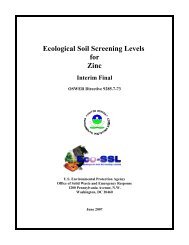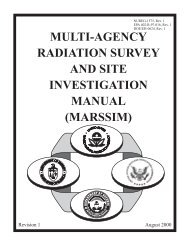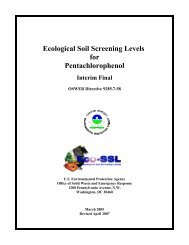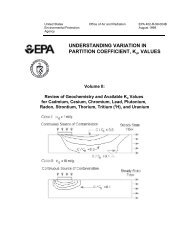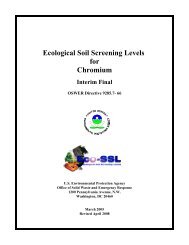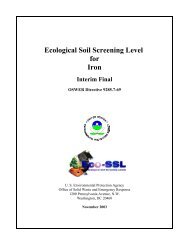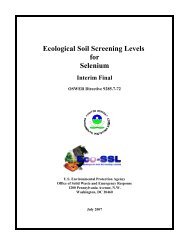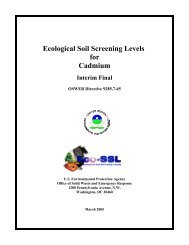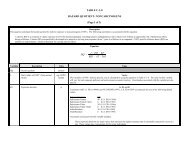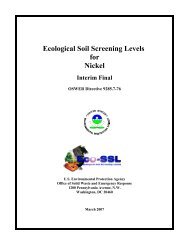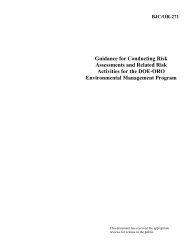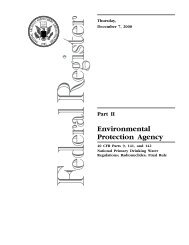C:\Eco-SSLs\Contaminant Specific Documents\Lead\November ...
C:\Eco-SSLs\Contaminant Specific Documents\Lead\November ...
C:\Eco-SSLs\Contaminant Specific Documents\Lead\November ...
You also want an ePaper? Increase the reach of your titles
YUMPU automatically turns print PDFs into web optimized ePapers that Google loves.
Rejection Criteria<br />
Literature Rejection Categories<br />
Description Receptor<br />
MODELING<br />
(Model)<br />
NO CONTAMINANT OF<br />
CONCERN<br />
(No COC)<br />
NO CONTROL<br />
(No Control)<br />
NO DATA<br />
(No Data)<br />
NO DOSE or CONC<br />
(No Dose)<br />
NO DURATION<br />
(No Dur)<br />
NO EFFECT<br />
(No Efct)<br />
NO ORAL<br />
(No Oral)<br />
NO ORGANISM<br />
(No Org) or NO SPECIES<br />
NOT AVAILABLE<br />
(Not Avail)<br />
NOT PRIMARY<br />
(Not Prim)<br />
NO TOXICANT<br />
(No Tox)<br />
NO TOX DATA<br />
(No Tox Data)<br />
NUTRIENT<br />
(Nutrient)<br />
NUTRIENT DEFICIENCY<br />
(Nut def)<br />
NUTRITION<br />
(Nut)<br />
OTHER AMBIENT<br />
CONDITIONS<br />
(OAC)<br />
Studies reporting the use of existing data for modeling,<br />
i.e., no new organism toxicity data are reported. Studies<br />
which extrapolate effects based on known relationships<br />
between parameters and adverse effects.<br />
Studies that do not examine the toxicity of Eco-SSL<br />
contaminants of concern.<br />
Studies which lack a control or which have a control that is<br />
classified as invalid for derivation of TRVs.<br />
Studies for which results are stated in text but no data is<br />
provided. Also refers to studies with insufficient data<br />
where results are reported for only one organism per<br />
exposure concentration or dose (wildlife).<br />
Studies with no usable dose or concentration reported, or<br />
an insufficient number of doses/concentrations are used<br />
based on Eco-SSL SOPs. These are usually identified<br />
after examination of full paper. This includes studies<br />
which examine effects after exposure to contaminant<br />
ceases. This also includes studies where offspring are<br />
exposed in utero and/or lactation by doses to parents and<br />
then after weaning to similar concentrations as their<br />
parents. Dose cannot be determined.<br />
Studies with no exposure duration. These are usually<br />
identified after examination of full paper.<br />
Studies with no relevant effect evaluated in a biological<br />
test species or data not reported for effect discussed.<br />
Studies using non-oral routes of contaminant<br />
administration including intraperitoneal injection, other<br />
injection, inhalation, and dermal exposures.<br />
Studies that do not examine or test a viable organism (also<br />
see in vitro rejection category).<br />
Papers that could not be located. Citation from electronic<br />
searches may be incorrect or the source is not readily<br />
available.<br />
Papers that are not the original compilation and/or<br />
publication of the experimental data.<br />
No toxicant used. Publications often report responses to<br />
changes in water or soil chemistry variables, e.g., pH or<br />
temperature. Such publications are not included.<br />
Studies where toxicant used but no results reported that<br />
had a negative impact (plants and soil invertebrates).<br />
Nutrition studies reporting no concentration related<br />
negative impact.<br />
Studies of the effects of nutrient deficiencies. Nutritional<br />
deficient diet is identified by the author. If reviewer is<br />
uncertain then the administrator should be consulted.<br />
Effects associated with added nutrients are coded.<br />
Studies examining the best or minimum level of a<br />
chemical in the diet for improvement of health or<br />
maintenance of animals in captivity.<br />
Studies which examine other ambient conditions: pH,<br />
salinity, DO, UV, radiation, etc.<br />
Wildlife<br />
Plants and Soil Invertebrates<br />
Wildlife<br />
Plants and Soil Invertebrates<br />
Wildlife<br />
Plants and Soil Invertebrates<br />
Wildlife<br />
Plants and Soil Invertebrates<br />
Wildlife<br />
Plants and Soil Invertebrates<br />
Wildlife<br />
Plants and Soil Invertebrates<br />
Wildlife<br />
Plants and Soil Invertebrates<br />
Wildlife<br />
Wildlife<br />
Plants and Soil Invertebrates<br />
Wildlife<br />
Plants and Soil Invertebrates<br />
Wildlife<br />
Plants and Soil Invertebrates<br />
Wildlife<br />
Plants and Soil Invertebrates<br />
Plants and Soil Invertebrates<br />
Plants and Soil Invertebrates<br />
Wildlife<br />
Wildlife<br />
Wildlife<br />
Plants and Soil Invertebrates



